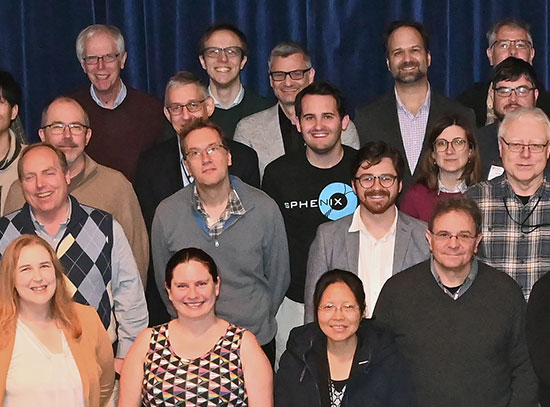Contact Karen McNulty Walsh
Multidisciplinary Drifting Observatory for the Study of Arctic Climate (MOSAiC)
Updates from Brookhaven scientists preparing instruments for an unprecedented expedition to the Arctic
For background on the MOSAiC expedition, see Scientists Prepare Ship…
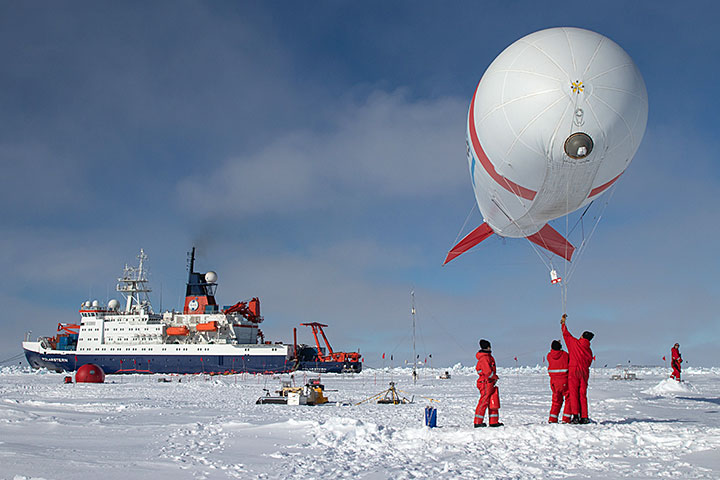
 The German icebreaker RV Polarstern Credit: Alfred Wegener Institute, Helmholtz Centre for Polar and Marine Research
The German icebreaker RV Polarstern Credit: Alfred Wegener Institute, Helmholtz Centre for Polar and Marine Research
October 16, 2019
It’s our last day on RV Polarstern with the feeling of mission accomplished. We are transferring to the other icebreaker today and this will be my last update until I get back to Norway.
The ARM instruments are set up and will hopefully run smoothly for the rest of the campaign during the drift. In case of any trouble, our amazing technicians will be there to tackle any issues. I wish them the best of luck. Even today new cracks and pressure ridges appeared in the ice in the middle of a power line, challenging our efforts to set up our camp.
As we prepare ourselves for the next ARM adventure on Andoya, a Norwegian island located within the Arctic Circle, it is crazy to think that we leave our instruments and our people in a such a remote place, drifting in the ice.
— Janek Uin, Brookhaven Lab/ARM Instrument Mentor, with Lauriane Quéléver of the University of Helsinki, who contributed to this update
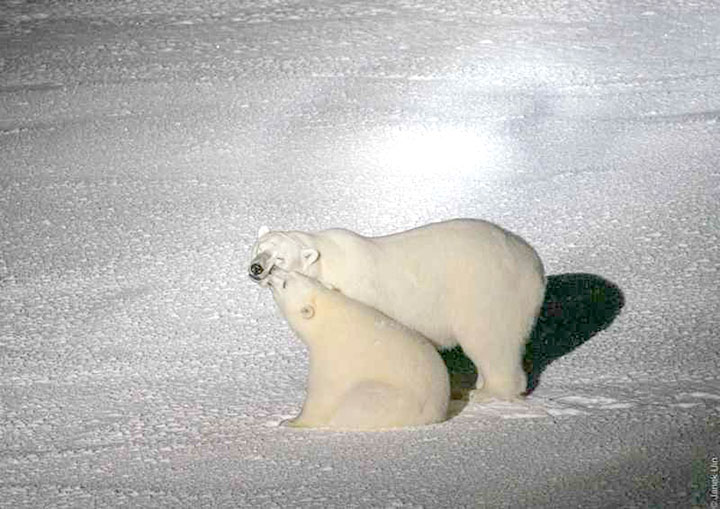
Two polar bears we saw a few days ago investigating our camp.
October 5, 2019
This was an incredible day for several reasons. After a few days of cargo operations with the other icebreaker, the Akademik Fedorov, today marks the first official day that the ship is parked in the selected ice floe to freeze in. The drift has begun! There are already teams of experts out working on the ice to survey and plan the setup of the scientific observatories on the floe. The days ahead will be very busy once a plan is in place.
Also, the weather was clear this morning, and we all woke up to a beautiful sunrise on the horizon. This sunrise was especially sweet for all of us currently on board the ship because it may have been the last direct sunlight the ship will see before the start of polar night!
After lunch, everyone on board was permitted to walk out onto the ice for a bit of recreation. It was a lot of fun to stretch our legs on the ice for a while and explore a little piece of the ship's home for the next year.
— Matt Boyer, Brookhaven Lab/ARM Instrument Mentor
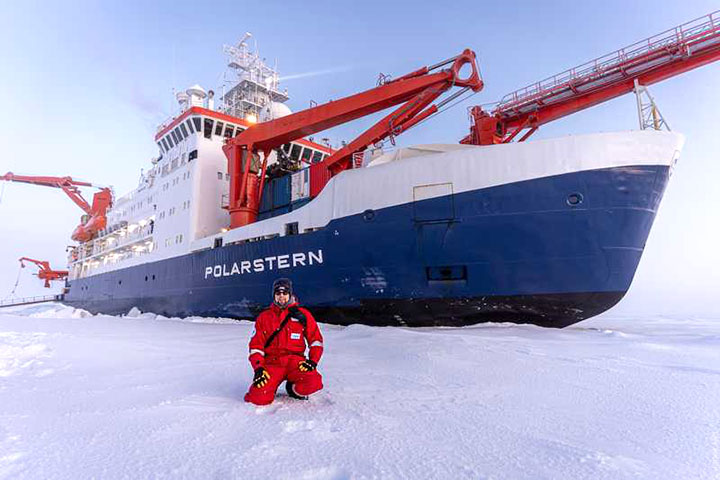
We are finally frozen in by our chosen ice floe and everybody was allowed to go on the ice near the ship for an hour. People were taking pictures and even playing football on the ice. Janek Uin (pictured above), Brookhaven Lab/ARM Instrument Mentor
85° 08' 35.6"N 133° 56' 13.1"E
October 4, 2019
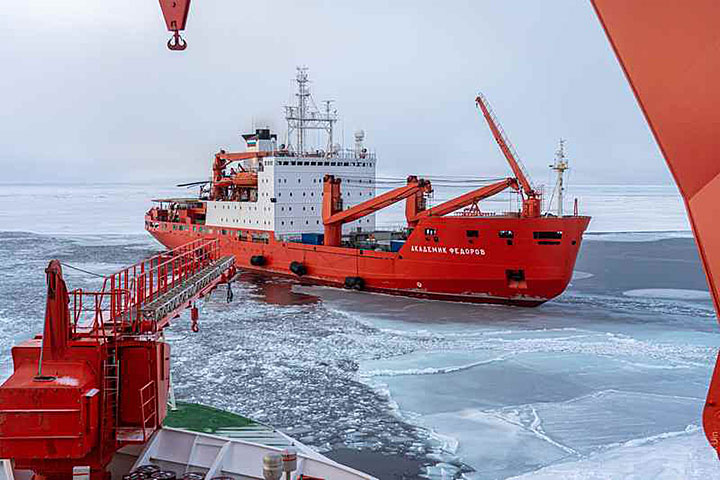
Meeting the Russian ice breaker to transfer equipment. Janek Uin, Brookhaven Lab/ARM Instrument Mentor
85° 03' 23.5" N 136° 54' 09.7" E
October 3, 2019
We finally found the piece of ice that will be the home for Polarstern for the next year. It's a floe a few kilometers in diameter and with thickness ranging from half a meter to a few meters. Several ice floes were surveyed via helicopters from both ice breakers and by teams of scientists taking measurements on ice before a decision to pick this one was made. Now the two ice breakers are tied together as equipment, fuel and people are transferred between the ships in preparation for deployment. While it's exciting to see many new faces on Polarstern, we also had to say goodbye to some of the friends we had made on our way here.
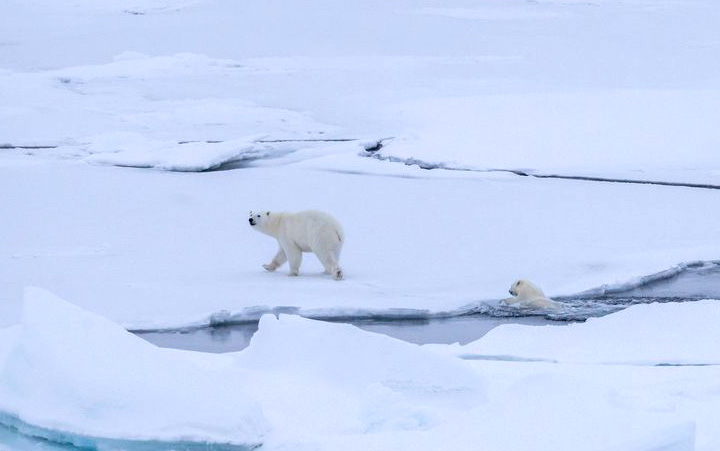
There was also a lot of excitement today as two polar bears — a mom with her cub — wandered very close to Polarstern. Everybody who could rushed to the deck to try to capture photos of them in the diminishing daylight. Janek Uin, Brookhaven Lab/ARM Instrument Mentor
85° 03' 23.5" N 136° 54' 09.7" E
October 1, 2019
It's currently a very exciting time here on the Polarstern. After several days of breaking ice and heading northeast to our intended target region, the search for a suitable ice floe has begun. We are currently parked next to a large floe that is several kilometers in diameter, and the sea ice specialists on board are out surveying the ice to determine if this will be the ship's home for the next year. Everyone on board is anxious to start setting up their instrumentation on the ice and start data collection. We are also working against the clock, as we are rapidly losing daylight hours. In just a few days, the sun will no longer reach above the horizon. So, if this floe is selected, the next few days will be very busy for everyone!
— Matt Boyer, Brookhaven Lab/ARM Instrument Mentor
84° 43' 20.0" N 131° 22' 20.8" E
September 29, 2019
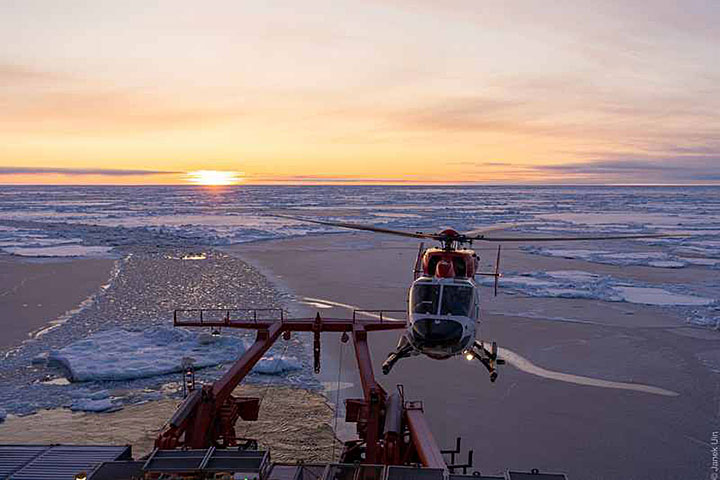
A helicopter returning scientists from a nearby ice floe. Measurements were made to determine whether this piece of ice would be suitable for the MOSAiC main base. Janek Uin, Brookhaven Lab/ARM Instrument Mentor
84° 29' 44.2" N 128° 44' 12.1" E
September 29, 2019
We are now heading north through thick ice towards the location that will be Polarstern's home for the next year.
Last couple of days were spent retrieving four Ocean Bed Seismometers that had been collecting data for the past year at the bottom of the ocean, almost 4 kilometers (2.5 miles) deep. The scientists responsible for these devices had remotely triggered their release from the ocean bed and had to find them among the ice once they surfaced. It took almost two days, but finally all four were found and hoisted on board.
The Russian icebreaker, Akademik Fedorov, which followed Polarstern out from Tromsø, joined us after finishing their separate tasks and is now about 30 miles ahead of us, helping to break the ice.
And to everyone's delight, after a week of cloudy skies and snow, the weather is finally beautiful. The skies are clear and the sun is shining over the endless field of ice and snow, while only reaching about 10 degrees above the horizon. There's very little wind and the temperature is around -10 degrees Celsius (14° Fahrenheit). We are all hoping that the weather stays pleasant as we near our freeze-in location and gear up for building the MOSAiC site.
— Janek Uin, Brookhaven Lab/ARM Instrument Mentor
81° 00' 46.0" N 105° 38' 37.1" E
September 25, 2019
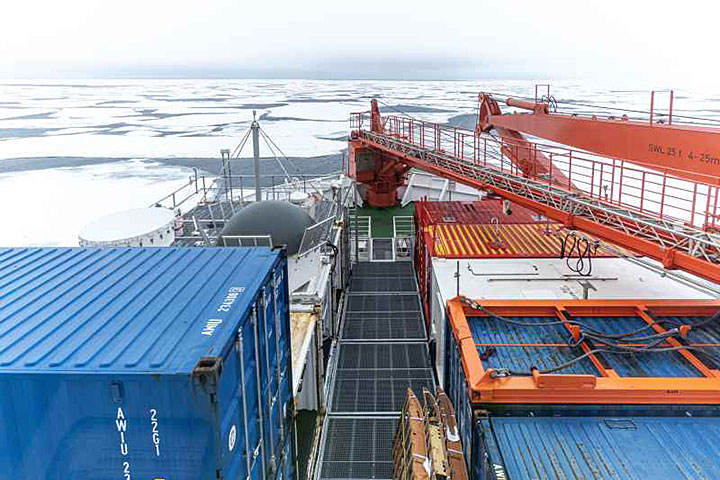
A view from the bridge of the Polarstern overlooking the measurement containers at the front of the ship. The Brookhaven Lab-built ARM AOS container is on the left with a long air-sampling inlet (gray stack) on the roof. Janek Uin, Brookhaven Lab/ARM Instrument Mentor
Today the ship moved farther eastward over northern Russia. The strong winds and the rough seas have subsided, and we have now reached the edge of the arctic ice. All day the ship has been navigating through fields of scattered icebergs, breaking through the ice as we continue our journey. It's quite a sight to watch the ice crack and break apart as the ship moves through it. Polar bear sightings have already been reported!
This evening, we began a series of scientific lectures, where volunteers can give talks about the science they are conducting during the expedition. We are surrounded by experts in atmospheric science, ecology, oceanography, and sea-ice formation. It's humbling to be a part of such an interdisciplinary expedition with so many other scientists, and it’s been a lot of fun learning from each other. I am looking forward to the days ahead!
— Matt Boyer, Brookhaven Lab/ARM Instrument Mentor
79° 52' 25.5" N 74° 55' 45.4" E
September 24, 2019 — Barents Sea
We have been underway now for almost four days. We just passed Novaya Zemlya island and should meet the ice in about a day. The weather has been fairly rough with three- to four-meter waves and the ship is pitching back and forth hard. It took everybody a few days to get their sea legs, but now we are used to the ship’s movement. We are even going running on the treadmills in the gym!
Going out to the measurement containers is limited due to the weather and seawater spraying on the deck. When I first went out to make sure my instruments were secure, I got a face full of Barents Sea.
The morale on the ship is high. People are enjoying excellent food and good company. These are the few quiet days before we park in the ice and the real work begins.
— Janek Uin, Brookhaven Lab/ARM Instrument Mentor
69° 40' 45.6" N 18° 59' 45.5" E
September 20, 2019 — Tromsø, Norway
Last day in Tromsø. Everybody is making final preparations for the voyage and getting ready for the farewell party later in the evening. We are still working on an instrument that failed earlier and we’re running out of ideas. At the last minute, we manage to fly in a replacement from the COMBLE campaign that ARM is setting up at the same time farther south in Norway. A big sigh of relief!
Farewell party in the evening on the dock by the Polarstern. Everyone who’s anyone in the environmental sciences is here. From the scientists to program managers and government officials. There are speeches and toasts. A band is playing upbeat music. Pictures are taken by news agencies and by family members saying goodbye.
We get the call to go on board. Only a few hours until departure. The party on the dock continues as we settle in on the ship and have our first dinner on board.
Finally, it’s cast-off time. People on the dock gather by the ship and we crowd the ship’s walkways trying to find a good vantage point. There’s music and final speeches. The ship’s captain together with the lead scientist for the expedition walk towards the ship and step into a small metal carrier which lifts them aboard. A light show is projected on the side of the ship. There’s powerful music and animated images of nature and wildlife.
The ship sounds its horn and starts slowly drifting away from the dock. The band plays a farewell tune, people on the dock wave with little white handkerchiefs and the nearby Russian ship, about to sale right after us, salutes with its horn. We watch the dock slowly blend in with the lights of Tromsø. It’s time to settle in and start our journey to the north. The MOSAiC expedition has officially begun.
— Janek Uin, Brookhaven Lab/ARM Instrument Mentor
69° 40' 45.6" N 18° 59' 45.5" E
September 20, 2019 — Tromsø, Norway
The Brookhaven National Laboratory team has been in Tromsø for a week, setting up the instruments in the Aerosol Observing System (AOS). Most of the instruments are up and running, others are waiting for departure before we switch them on. The atmosphere on and around the ship is hectic—a lot is going on as all the different participants of the expedition are loading and configuring their equipment. But everyone is very positive and eager to set sail. Thanks to the hard work of both the German crew and the Atmospheric Radiation Measurement (ARM) Los Alamos National Laboratory team, we are ready to sail to the North Pole in just a few hours!
— Janek Uin, Brookhaven Lab/ARM Instrument Mentor
Brookhaven Lab’s participation in MOSAiC is supported by the DOE Office of Science. The ARM Research Facility operates as a DOE Office of Science user facility.
Brookhaven National Laboratory is supported by the U.S. Department of Energy’s Office of Science. The Office of Science is the single largest supporter of basic research in the physical sciences in the United States and is working to address some of the most pressing challenges of our time. For more information, visit https://www.energy.gov/science/
Follow @BrookhavenLab on Twitter or find us on Facebook.




